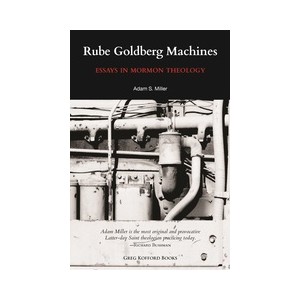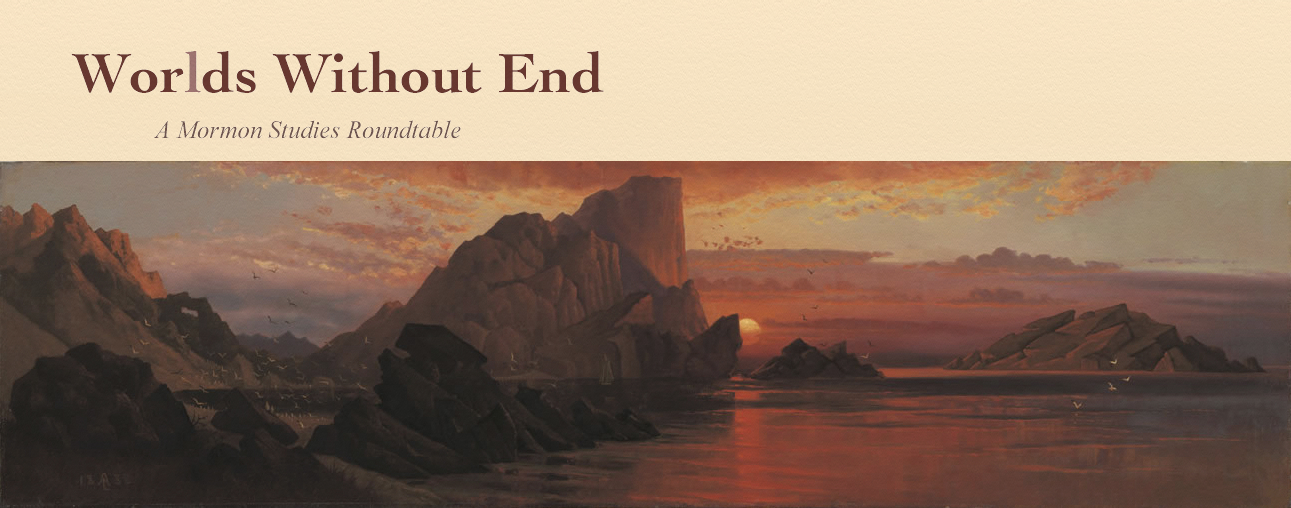
Miller, Adam S. Rube Goldberg Machines: Essays in Mormon Theology. Draper: Greg Kofford Books, 2012.
——
A comically involved, complicated invention, laboriously contrived to perform a simple operation. —“Rube Goldberg,” Webster’s New World Dictionary
When one thinks of theology, rarely does the term “delightful” come to mind. For me, the word hardly, if ever, finds it way into any of my conversations or writing.
Yet, “delightful” is the exact word to describe Adam S. Miller’s Rube-Goldberg Machines: Essays on Mormon Theology published by Greg Kofford Books. As Miller points out in his introduction, many theologians take themselves far too seriously and by so doing, miss out on the joy of theological exercise.
Miller compares doing theology to constructing a Rube Goldberg machine and by so doing, communicates to the reader that this collection of essays is not about some ultimate theological end, but rather, is meant to be enjoyed as a journey of spiritual reflection. Miller implicitly rejects systematic theology but is quite careful to distinguish theology from doctrine. Doctrine, by its very nature, must be systematic. Theology, on the other hand, is fluid, flexible and gratuitous. Why?
… there is a kind of joy in theology’s gratuity, there is a pleasure in its comedic machination, and ultimately—if the balloon pops, the hamster spins, the chain pulls, the bucket empties, the pulley lifts, and (voila!) the book’s page is turned—some measurable kind of work is accomplished. But this work is a byproduct. The beauty of the machine, like all beauty, is for its own sake. — pp. xiii
Theology, then, is a good to be enjoyed it itself. Miller most certainly makes Mormon theology enjoyable and in the process provides unique insights and perspectives that neither Latter-day Saints, nor students of Mormonism, may have previously considered. I was personally very moved by Miller’s discussion of the Atonement. His view that the Atonement must involve a sense of innate givenness and, at least in part, serves as a reminder to be forever mindful of, and thankful for, the present moment. Mormon doctrine is so focused on the eternal that Miller’s treatment of the Atonement reads as a refreshing reminder to enjoy the divine now, rather than ignoring today’s givenness while planning to enjoy the joy of divinity at some future date.
Perhaps most importantly, Miller suggests a purpose for theology that is “worth only the amount of charity is is able to show.”
A critical theology is chartered by charity. Doing this kind of work is different from weighing history, deciding official doctrine, or inspiring devotion. Theology speculates. It experiments with questions and advances hypotheses. It tests new angles and pulls loose threads. Theology, in this sense, is not an institutional practice. It has no force beyond the charity it demonstrates and it decides no questions beyond what the Brethren have settled.
Just as life decides the scope of biology, charity decides the span of theology. Theology is worth only as much charity as it is able to show. — pp. 59
Miller’s recognizes the centrality of sacred texts to Mormon theology but also notes that these “texts, rather than being static recordings, are dynamic, meaning-making machines.” The Standard Works can be read in several ways, one of which is theologically. Once again relying on the fluidity of theology, Miller explains:
“Theology runs experiments for the sake of mapping a text’s own latent patterns. Its power to illuminate these latent patterns derives from its freedom to pose hypothetical questions: if such and such were the case, then what meaningful pattern would the text produce in response?” — pp. 61
Further, Miller writes:
Thus, when read theologically, the historical, doctrinal, and exegetical dimensions of scripture are essential but not decisive. In addition to these, theological readings involve an explicitly creative engagement with the text that depends on both the details of the text’s latent patterns and the hypothetical questions that, as with chemicals and an undeveloped negative, create a reaction that can bring novel patterns into developed focus. Theological readings aim to develop a text’s latent image of Christ.
However, because it is hypothetical, theology is always tentative and nonbinding. Theology, though sensitive to what is normative, never decides doctrine. — pp. 61
Miller explores many other aspects of Mormon theology from eternal marriage, to the meaning of humanism within a Mormon context.
The layout of early chapter hearkens back to works of the 19th century where philosophers and ethicists laid out grandiose arguments point by point in a numbered fashion. This layout works well for the chapters Smith employs it as he lays premise upon premise until reaching a conclusion only to assert that conclusion as yet another premise to be built upon.
There are, of course, essays with which I found some minor quibble or complaint. But these essays are not to be engaged critically — we are, after all, dealing with the comical complexity of a Rube Goldberg machine. Reading these essays is an experience to be enjoyed not for their theses. Rather, they are to be enjoyed, just as the theology they explore, in the moment.
In a particularly moving essay entitled Groundhog Day, Miller explores the incessantly repetitive nature of our lives which causes us to be constantly focused on the future. We all chase desires that we believe will make us happy. Yet, once we achieve that desire we find that happiness, or at least the absence of irritation or pain, eludes us. Miller concludes:
“If we go to hell,” Joseph Smith claimed, “we will turn the devils out of doors and make a heaven of it.” If life is repetition, I am claiming, then we must turn our daydreams out of doors and fashion a heaven from it. There is no help on the way. Eternity is all just more of the same. Novelty is a red herring: the last refuge of that dream that is your ego. No one is coming to save you from the grace of the mundane.
Jesus came to give this grace not take it away.
Breathe.
Nothing could be more merciful. — pp. 124
I recommend Miller’s creative collection of essays to anyone with an interest the theological richness, as opposed to the supposed doctrinal rigidity, of Mormonism. The reader will come away with a fresh perspective and truly unique insights into elements of Mormon theology long-considered settled and definitively understood.

Nice.
See my review at http://www.scribd.com/doc/118815850/ADAM-MILLER-REVIEWED-pdf .
I tripped upon the essay “Groundhog Day” at my neighborhood Deseret Bookstore on this February 2nd. What a humorous treat! Thank you for adding a new point of view to my favorite Bill Murray film.
Pingback: Ask the Scholar: Adam S. Miller edition | Neal A. Maxwell Institute for Religious Scholarship